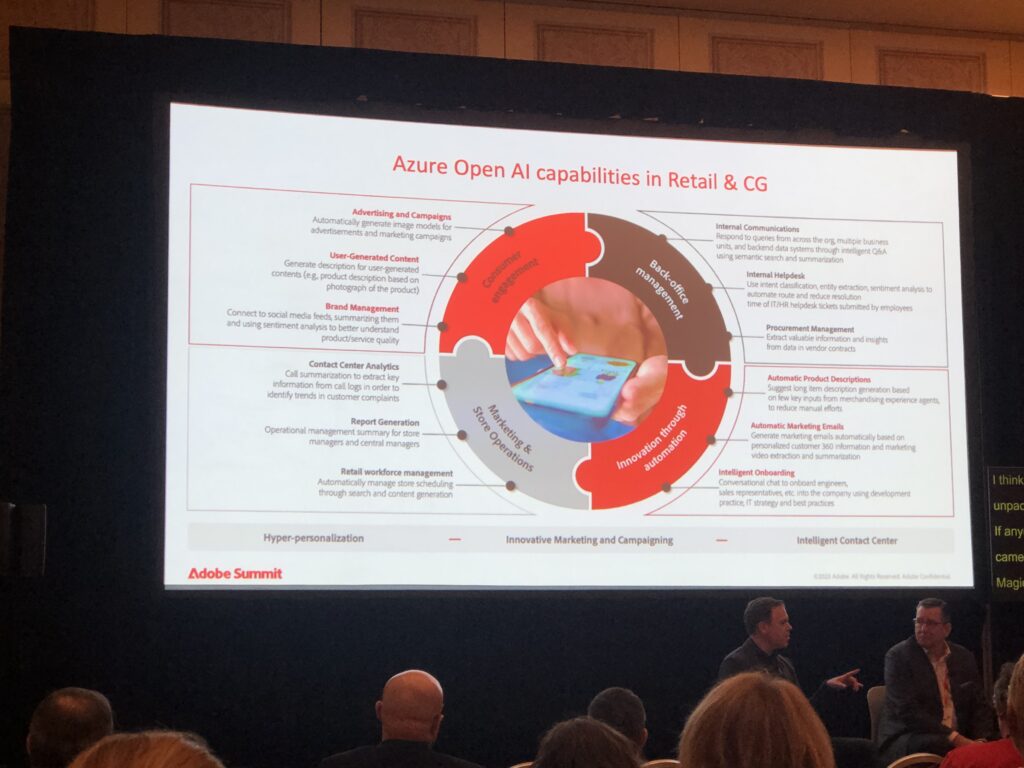How Enterprise Companies Are Pitching Generative AI to Marketers
Driving relevance means driving growth. Join global brands and industry thought leaders at Brandweek, Sept. 11–14 in Miami, for actionable takeaways to better your marketing. 50% off passes ends April 10.
With tech giants now beginning to work the latest advances in generative artificial intelligence into their enterprise offerings, their next step is selling businesses on the potential of the technology.
This year’s Adobe Summit is offering a preview of what that pitch might look like when it comes to marketers, some of whom have been wading carefully into this kind of content automation due to the unsettled legal and ethical issues around its use.
Major software providers address those concerns by weaving the tech into existing, trusted tools. Microsoft, Google, Adobe and Nvidia have each announced suites of business-focused features this month that capitalize on cutting-edge machine learning tech able to produce passably realistic text or imagery.
At Adobe Summit in Las Vegas this week, the creative software giant and its partners are framing generative AI in terms of the various roles it can play in different steps of the content supply chain, Adobe’s term for the process of building creative digital marketing messages, from ideation to performance analytics.
In short, marketers are expected to generate much more marketing content than ever before as digital channels have proliferated and more of their respective business operations have moved online, Adobe execs say. The company said that marketing content demand has doubled in the last two years, and it’s expected to grow five-fold in the next two years.
In that environment, Adobe frames artificial intelligence as a copilot that can augment and automate rote tasks at every stage of the creation, distribution and analytics pipeline. In addition to announcements around new generative AI tools, the company also rolled out an enterprise tier of its pared-down Express product, another offering designed to make it easier for marketers to put out more content more quickly.
“A lot of what we announced fit in that strategy of helping drive content at scale … There’s just so much content to create to truly get to personalization,” said Ashley Still, senior vice president & general manager of digital media at Adobe. “If generative AI can help the creatives themselves, and the marketers produce and iterate on content more quickly, that will help accelerate content development.”
Meanwhile, Microsoft has begun to integrate models like GPT-4 and image generator Dall-E 2 from OpenAI, in which it has heavily invested, into its Azure enterprise cloud computing services. Microsoft has also partnered with Adobe to supply its language AI to help write marketing messages and photo captions within the latter’s marketing platform.
Speaking at Adobe Summit, Mike Edmonds, Microsoft’s senior director of strategy for worldwide retail and consumer goods, made the case for brands using AI in similar terms. Edmonds outlined a number of different capabilities for which it is positioning OpenAI Azure as a solution, including marketing emails, customer service summarization and product descriptions–citing Shopify’s recently launched tool that auto-generates such listings as an example.

“Retail and consumer goods companies are under immense pressure, whether it’s on a macro level with things like economic uncertainty … or compounded with customer expectations that are still going to continue to be through the roof,” Edmonds said. “There is a ton of pressure to be able to do more with less. So, that’s why we’re talking about AI in the context of the content supply chain.”
While companies are still mostly in the experimental phase when it comes to testing out these various generative AI capabilities, Adobe’s Still said she expects to see the technology begin to meaningfully affect marketing operations in the next year or two.
“It’s gonna have impact pretty quickly,” Still said. “We’re very focused on integrating the technology into applications like Photoshop and Illustrator to make content creation faster.”
https://www.adweek.com/brand-marketing/how-enterprise-companies-are-pitching-generative-ai-to-marketers/
